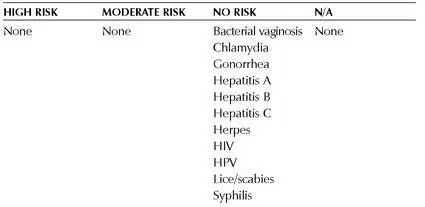Though rimming is certainly enjoyable, it isn’t a very safe activity. Unprotected rimming can transmit hepatitis A, anal herpes, anal warts, and possibly viruses such as HIV. Always use a barrier for rimming—but if you insist on barrier-free rimming, get a hepatitis A shot. Read about erotic rimming techniques in chapter 10, “More Techniques.”
Some STDs are easier to transmit than others. Let’s look at the most common STDs and their relative risks for transmission during fellatio.
HIV
HIV is transmitted when the blood of an infected person enters another person’s bloodstream via an open cut, sore, or blood vessel. According to the Centers for Disease Control, HIV has also been found in varying amounts in semen, vaginal fluid, breast milk, and pre-come. The CDC cautions against allowing the blood of an infected person to make contact with mucous membranes. If you perform unprotected fellatio, you may be at risk, especially if you have a cut or sore on your lips or in your mouth (perhaps from recently brushing or flossing your teeth). While great strides have been made in managing HIV infection, there is no cure for HIV. The virus can lie dormant in the body for a very long time and can be transmitted even when there are no symptoms present. The person infected with HIV may not even know they have it.
Fellatio (Giving)

Fellatio (Getting)

Rimming (Getting)

Rimming (Giving)

Sharing Sex Toys

Deep Kissing

Dry Kissing

Hepatitis
Hepatitis A, B, and C infect millions of people worldwide and can be asymptomatic for years before liver disease is evident. Hepatitis A is transmitted through oral-fecal contact and can be contracted when rimming an unprotected partner (for more on rimming, see the section above). Hepatitis B is very similar in transmission to HIV: it is found in blood and other body fluids, such as semen, vaginal secretions, breast milk, and tears. You contract hepatitis B when fluids from a carrier, such as pre-come or ejaculatory fluid, enter your body via an opening such as a cut or sore in your mouth. Hepatitis C is found only in the blood of an infected partner. That doesn’t mean, however, that you shouldn’t treat it like any other serious virus, and if you think your partner might be infected you should follow safer-sex guidelines at all times when performing fellatio. Hepatitis A has no chronic or long-term infection; there is a vaccine to prevent both hepatitis A and B, and they can be can be treated in some cases; there is no cure or vaccine for hepatitis C.
Herpes
Herpes is an extremely contagious STD. There are basically two types of herpes—oral and genital—and what lives in the mouth can easily take up residence in the genitals. Herpes is spread when sores or shedding skin from an infected partner make contact with mucous membranes—penis to mouth and mouth to penis—as well as through skin-to-skin contact, such as hand-to-penis or hand-to-anus contact. That’s why you should use gloves with your condoms—fellatio is almost always a hands-on activity, and you’ll definitely want to touch your partner’s penis, balls, and/or anus while going down on him. While it’s true that the herpes virus is benign when not active, the CDC states that it’s possible to contract herpes between eruptions, when the skin is shedding (before an outbreak). An outbreak can range from a collection of blistering, painful sores to one small sore that can be unknowingly tucked in a fold of skin. There is no cure for herpes.
HPV
Human papillomavirus (HPV) is the virus associated with genital warts. However, you can have HPV and never have a genital wart; in fact, most people who have HPV do not know they have it, because it usually causes no symptoms. Approximately ten of the thirty identified strains of HPV can lead to the development of cervical cancer in women. HPV is spread much like herpes, through skin-to-skin and mucous membrane contact when the virus is apparent or simply shedding. It should be considered highly contagious, and you are at much higher risk for contracting HPV through fellatio than you are for contracting HIV or hepatitis. The symptoms of HPV can take several weeks or even months to appear, if they appear at all. They can be small, painless bumps or look like a collection of cauliflower-like constellations, appearing on the penis, scrotum, thighs, mouth, anus, or vagina. Again, gloves and condoms are advised, but if you see symptoms you’ll want to avoid sexual contact until the outbreak has cleared up, since HPV is spread by touch and can appear in areas condoms don’t cover. There is no cure for HPV.
Bacterial STDs
Gonorrhea, chlamydia, and syphilis are bacterial STDs that are spread through unprotected sexual contact. You are at much more at risk of contracting gonorrhea or syphilis through fellatio than you are of contracting HIV or hepatitis. Though transmission of chlamydia through fellatio is unlikely, it has been shown to appear in the throat. Unless you and your partner have been tested for chlamydia (which usually has no symptoms or looks like mild gonorrhea or a yeast infection), it’s safest to use condoms. Gonorrhea can be spread via unprotected oral contact, as can syphilis if there is a sore (chancre) present on your mouth or his penis. These STDs can be treated with antibiotics, but if left undetected they can become serious.
Sexually transmitted diseases can remain dormant for months or even years after exposure, so it’s possible to pass on something you didn’t even know you had. This is why it’s essential to use barriers—latex or nonlatex—when coming in contact with a partner’s sexual fluids.
If either you or your partner has an STD, safer-sex practices are required to prevent transmission. If one of you has a viral STD, such as hepatitis C, HIV, HPV, or herpes, use latex (or non-latex, such as nitrile or polyurethane, but not animal skin, such as lambskin condoms—see “Condoms” below for more information) barriers during fellatio. It may also be helpful to talk to your physician or an STD prevention specialist (see chapter 13, “Resources,” for hotlines and organizations) about the risks for transmission in your particular case.
If one of you has a bacterial infection such as chlamydia, you must use barriers until you’ve completed treatment. If you have a cut or bite in your mouth, the risk to both partners is greatly increased. Keep this in mind if you’ve recently brushed or flossed your teeth, both of which can cause tiny cuts and bleeding in your mouth. Don’t despair—there are many options out there for the orally inclined apprentice who wants to stay safe.
Читать дальше



















